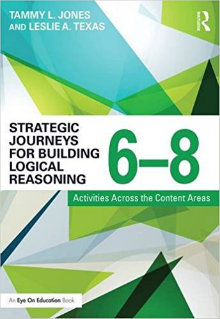Build Logical Reasoning in Content Areas
Strategic Journeys for Building Logical Reasoning 6-8: Activities Across the Content Areas
By Tammy L. Jones and Leslie A. Texas
(Routledge/Eye on Education Book, 2017 – Learn more)

This book, for grades 6-8, is one of a series to help build reasoning skills. The previous two books are for grades K-5 and 9-12. The authors, who have vast experience as classroom teachers and consultants, have also co-authored another series on mathematical practices.

Meaningful, relevant writing by students
The authors desire teachers across disciplines and grade levels to give students opportunities to authentically engage in meaningful, relevant writing. The authors argue that talking and writing are two different skill sets.
The Journey’s Notebook is another strategy they recommend for changing how teachers teach and students learn. This notebook is a place for students to write using content-specific language and has two main components, a Glossary and The Journal.
At one point they suggest the ELA teacher go into other classrooms and share what a good paragraph looks like so there are common expectations. It seems, actually, it would be good for the ELA teacher to be the one to demonstrate and model most of the strategies.
Understanding content through logic
Chapter 3 aims to bring students to deeper understandings of content through logical reasoning. The authors provide three phases of the Logical Reasoning Process. An LRP graphic organizer is presented as a tool “for students who need a supporting structure to help organize their work flow.” After explaining the process, the authors give examples, such as the “Apples in a Bowl” exercise for mathematics for secondary students to review their understanding of fractions.
Strategies to engage students
Chapter 4 offers more strategies to engage students, such as a fun pre-assessment strategy called “Matching Mania.” There are also “Grid Games” to use for assessment or review as well as a “Visual Vocabulary” section. Teachers can pick and choose which strategies they will use.
Chapter 5 asks “How do students know that they know?” There are “Questions & Look Fors” for teachers, students, teacher leaders and coaches, and administrators to help guide the conversation during and after walk-throughs as students go through the phases of logical reasoning.
Appendix A: “Logical Reasoning Process Tools and Sample Tasks” gives a reproducible graphic organizer and a simplified list of ideas for using it. Appendix B: “Opportunities for Writing Strategies and Samples” gives prompts and visuals, like a forensic word cloud from which to write two statements about forensics and with a group create a paragraph. Appendix C: “Practice to Proficiency Strategies and Samples” gives, for example, some “Matching Mania” reproducibles for different subject areas. Appendix D: “Practices from the Academic Standards” discusses the standards in the various content areas.
The roles of ELA and content area teachers
For years secondary language arts teachers have felt that they carry an extra burden of teaching and grading writing and of being the experimenters with different strategies to get at deeper learning. For the strategies in this book to be implemented and used on a regular basis, I suspect that it will most likely need to be English language arts teachers who serve as guides, as the authors suggest a couple of times.
The content area experts, however, will need to be the ones who do the assessment part to see if students really are building better logical reasoning skills. If a school can agree to use the common language in this book, there is the potential for more intense rather than surface learning.
Dr. Mary Langer Thompson’s articles, short stories, and poetry appear in various journals and anthologies. She is a retired school principal, who now writes and teaches writing workshops in schools, prisons, and in her community.

































